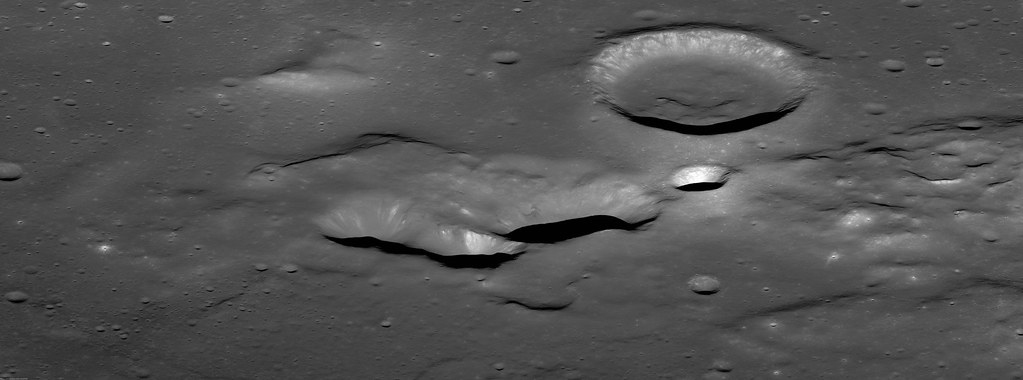 |
| An early morning view looking east-to-west from an altitude of 86 km across the southern portion of the Lassell Massif, an irregularly shaped series of hills and steep-walled depressions. North is to the right in this LROC NAC oblique mosaic M1108311369LR, LRO orbit 15611, November 23, 2012; 71.73° incidence angle, spacecraft and camera slew 56.64° from orbital nadir, resolution above 2 meters from 85.65 km over 14.63°S, 355.69°E [NASA/GSFC/Arizona State University]. |
LROC News System
The Lassell Massif is a complex area of rugged terrain located in northeastern Mare Nubium (14.7°S, 351.0°E). This undulating terrain of hills and steep-walled depressions is 45 km across from north to south and 25 km across from east to west.
The southern portion of the massif comprises several prominent elongate depressions (like Lassell K and Lassell G, seen below) that are clustered together.
 |
| The Lassell Massif in Mare Nubium; north is to the right. Prominent features of the Lassell Massif region include Lassell C, K, and G [NASA/GSFC/Arizona State University]. |
Lassell K and G could, however, instead represent a series of clustered impact craters, which are relatively common on the Moon.
pyroclastics, a subdued or mantled terrain, and even a possible volcanic cone.
Taken together, these features suggest a complex volcanic history for this region. If the Lassell Massif is constructed from a series of volcanic extrusions, it may represent an unusual type of silicic volcanism on the Moon (perhaps similar in composition to rhyolite).
Taken together, these features suggest a complex volcanic history for this region. If the Lassell Massif is constructed from a series of volcanic extrusions, it may represent an unusual type of silicic volcanism on the Moon (perhaps similar in composition to rhyolite).
Read more about the Lassell massif and its unusual style of volcanism in a study presented by members of the Lunar Reconnaissance Orbiter Camera team and colleagues to the 44th Lunar and Planetary Science Conference (2013): "The Lassell Massif, Evidence for Complex Volcanism on the Moon," #2504.
The full oblique image (below) along with other images and compositional data sets may reveal more clues to the timing and nature of volcanism in the Lassell region. However, returning rock samples to Earth and exploring the slopes of this structure from the surface may be the only way to confirm its origins.
 |
| View assorted sizes of an unlabeled sample of a mosaic from the LROC observation above, HERE. |
Related LROC Featured Images:




No comments:
Post a Comment